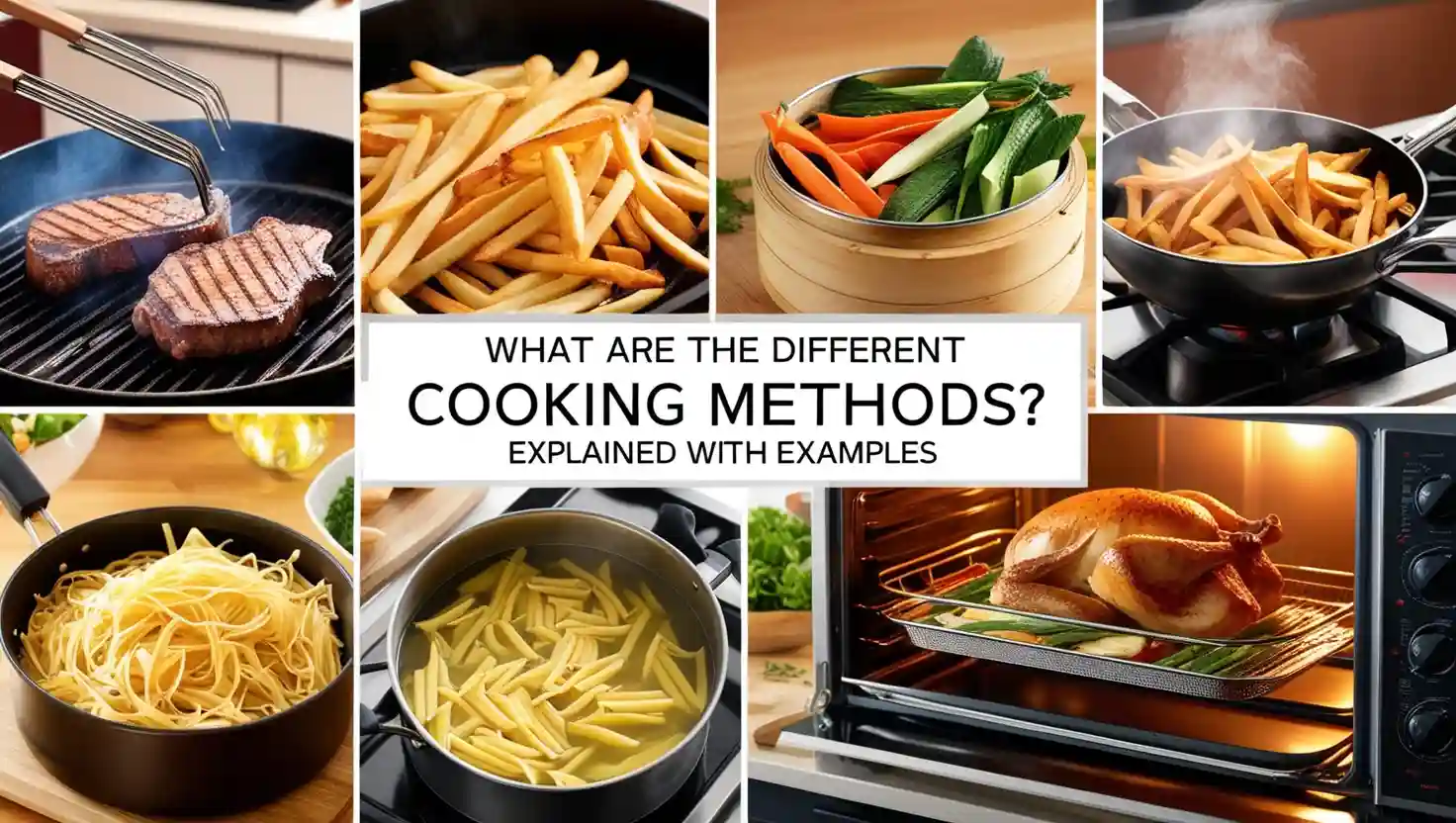Cooking is both an art and a science, involving various cooking techniques that transform raw ingredients into delectable dishes. Understanding these methods is crucial for both novice cooks and seasoned chefs, as each technique imparts unique flavours, textures, and nutritional profiles to food. Broadly,
Cooking methods can be categorised into three main types: dry heat cooking, moist heat cooking, and combination cooking.
This comprehensive guide delves into each category, exploring the specific techniques, their applications, and the nuances that make them distinct.
Want to dive deeper into the history of cooking or explore food safety practices? Check out the full Cooking article on Wikipedia.
Quick Review: This guide breaks down different cooking methods into Dry Heat, Moist Heat, and Combination Cooking techniques. Learn when and how to use each method to enhance your cooking skills!
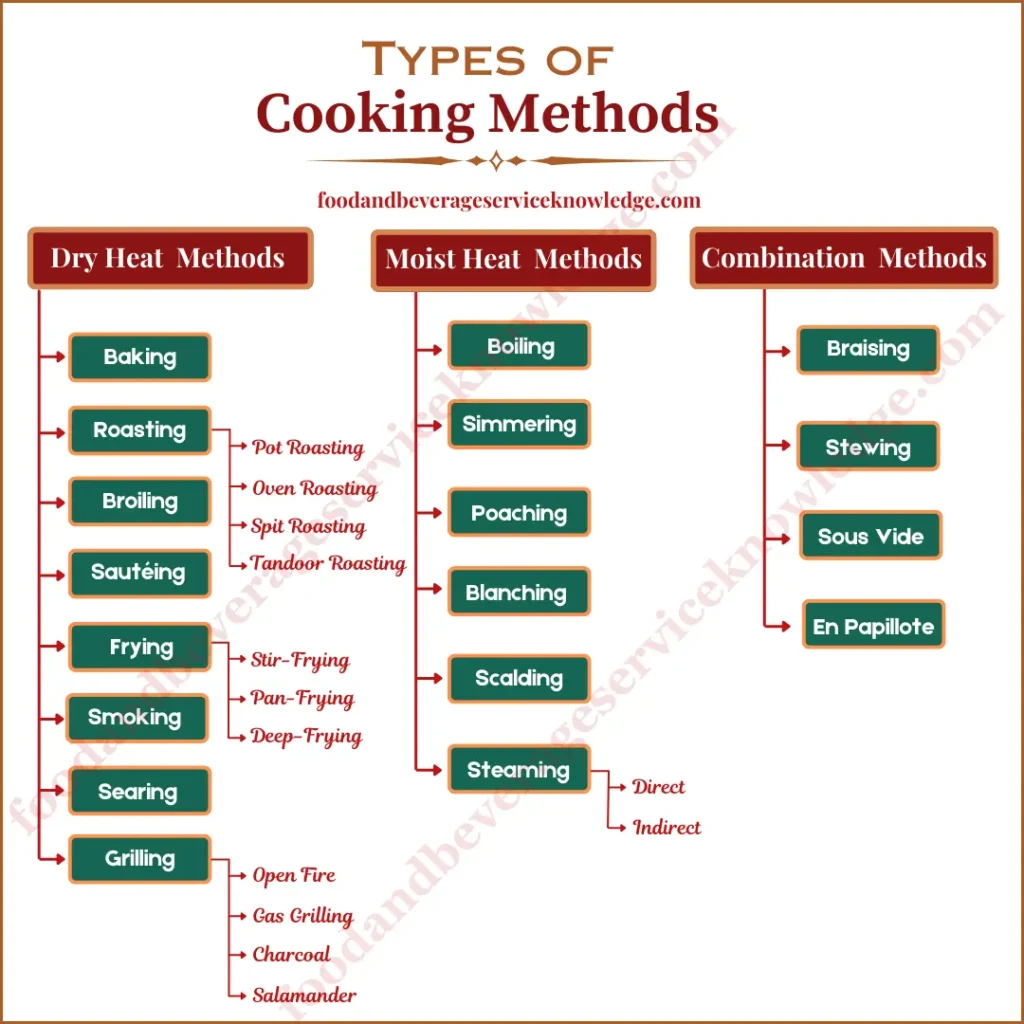
1. Dry Heat Cooking Methods
Dry heat cooking methods involve cooking food without the use of water or moisture, relying instead on the circulation of hot air or direct contact with fat to transfer heat. These techniques typically result in the caramelisation or browning of the food’s surface, enhancing flavours and creating appealing textures.
1.1 Baking
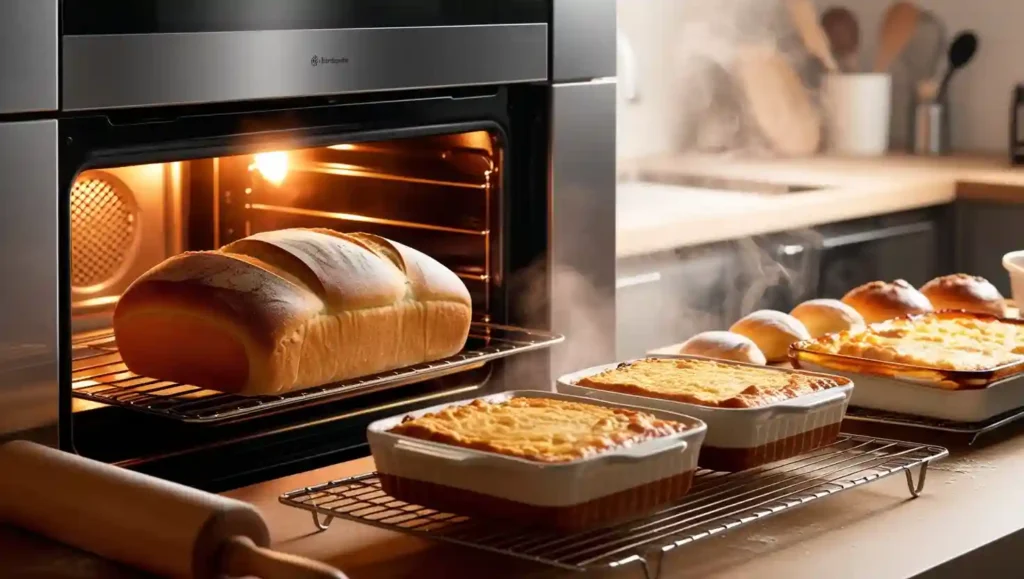
Baking is a method of cooking food by surrounding it with dry heat in an oven. This technique is commonly used for preparing bread, pastries, and casseroles. The dry heat causes the food’s surface to brown, adding flavour and texture. The degree of dryness can be modified by the amount of steam produced from the item being baked. Proper temperature control ensures even cooking and prevents dryness.
Applications:
- Breads and Pastries: Yeast breads, cakes, cookies, and pies.
- Savoury Dishes: Casseroles, baked pasta dishes, and roasted vegetables.
Advantages:
- Even cooking and browning.
- Enhanced flavours through caramelisation.
- Retainsthe shape and structure of food.
Considerations:
- Requires precise temperature control.
- May result in dry textures if overcooked.
- Baking times vary depending on the type of food and oven settings.
1.2 Roasting
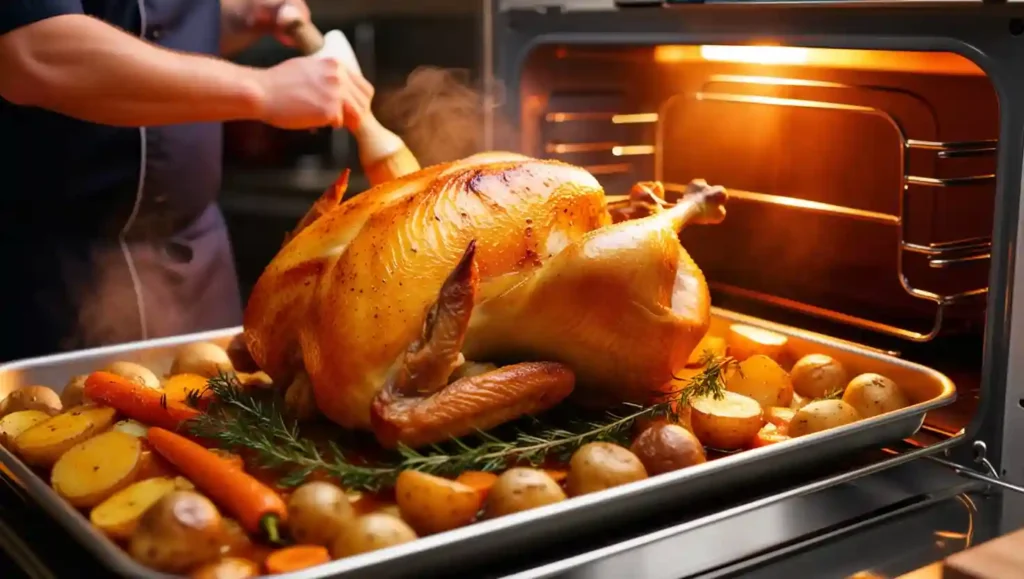
Roasting involves cooking food, typically meats and vegetables, by exposing them to dry heat in an oven or over an open flame. This method enhances the natural flavours of the food through caramelisation and Maillard browning on the surface. It is often used for large cuts of meat or whole vegetables, developing a rich, deep flavour and a crispy outer layer. Roasting requires controlled temperature adjustments for the best results.
Types of Roasting Methods:
✅ Pot Roasting
Pot roasting is a slow-cooking method where meat is browned and then cooked in a covered pot with minimal liquid. This technique helps retain moisture and enhances flavour while breaking down tough connective tissues. It is ideal for high-quality meats, small joints, and poultry, ensuring tenderness and juiciness. Cooking at a low temperature over time results in deeply flavorful, melt-in-the-mouth dishes.
✅ Oven Roasting
Oven roasting involves cooking food in a roasting tray inside an oven with dry heat and added fat. Meats and vegetables are often browned before roasting to seal in juices and enhance flavour. Aromatic herbs and vegetables can be added to infuse additional depth. This method creates a crispy outer layer while maintaining a moist and tender interior.
✅ Spit Roasting
Spit roasting involves cooking food on a rotating spit over an open flame or heat source, ensuring even cooking. The rotation allows juices to self-baste the meat, resulting in a crispy crust and a succulent interior. This method is commonly used for whole poultry, large cuts of meat, and traditional barbecue dishes. The use of wood or charcoal adds a distinct smoky flavour.
✅ Tandoor Roasting
Tandoor roasting is done in a traditional clay oven heated by charcoal, gas, or wood, creating high, dry heat. Meats, seafood, and Indian bread are often marinated in spiced yoghurt before being cooked at intense temperatures. This method imparts a smoky, charred flavour while keeping the inside moist and flavorful. The combination of radiant heat and air circulation ensures fast, even cooking.
Applications:
- Meats: Whole poultry, beef roasts, pork loins.
- Vegetables: Root vegetables like potatoes, carrots, and beets.
Advantages:
- Develops complex flavours and appealing textures.
- Allows for cooking large cuts of meat or whole vegetables.
- Enhances moisture retention with proper basting techniques.
Considerations:
- Requires longer cooking times.
- Needs occasional basting to prevent drying out.
- Uneven cooking may occur if the heat distribution is not managed properly.
Serious Eats provides expert tips on perfecting the art of roasting to enhance your culinary creations
1.3 Grilling
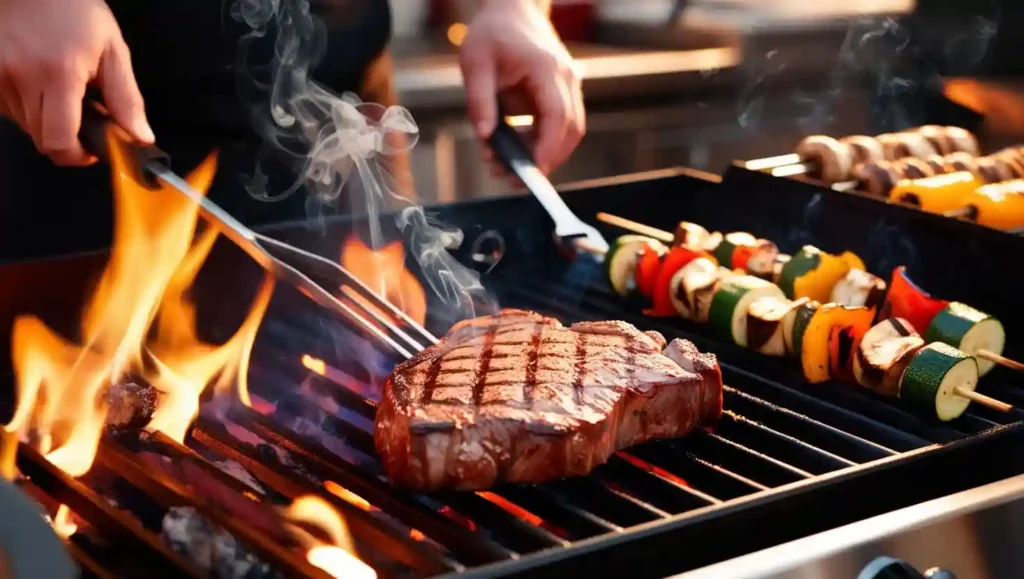
Grilling is a high-heat cooking method where food is placed on a grill rack over an open flame or heat source. This technique imparts a distinct smoky flavour and attractive grill marks to the food. It is widely used for meats, seafood, and vegetables, providing a charred, crispy exterior while keeping the inside tender and juicy. Proper grilling techniques and temperature control help prevent burning and ensure even cooking.
Types of Grilling Methods
Grilling methods vary based on the heat source and cooking technique, each providing distinct flavours and textures.
1. Open Fire Grilling
This traditional grilling method involves cooking food directly over an open flame, typically using wood or charcoal. The high heat creates a smoky aroma and enhances the natural flavours of meats and vegetables. It requires careful attention to prevent burning and ensure even cooking.
2. Charcoal Grilling
Charcoal grilling uses burning charcoal briquettes or lump charcoal as the primary heat source. It provides a rich, smoky flavour and intense heat, perfect for achieving deep grill marks and caramelisation. Controlling temperature involves adjusting airflow and coal distribution.
3. Gas Grilling
A convenient and efficient grilling method that uses propane or natural gas as the heat source. Gas grills offer precise temperature control, making them ideal for consistent cooking. While they lack the intense smokiness of charcoal, they provide quick heating and even cooking.
4. Salamander Grilling
This method uses a high-intensity overhead heat source, commonly found in professional kitchens. It is perfect for finishing dishes, melting cheese, or creating a crispy, caramelised surface on meats and seafood. The rapid, direct heat ensures a golden-brown crust without overcooking the interior.
Applications:
- Meats: Steaks, burgers, chicken breasts.
- Seafood: Fish fillets, shrimp, and scallops.
- Vegetables: Bell peppers, zucchini, corn on the cob.
Advantages:
- Quick cooking with flavorful, charred exteriors.
- Adds a smoky aroma and taste.
- Retains nutrients and enhances natural flavours.
Considerations:
- Requires attention to prevent overcooking or burning.
- May produce harmful compounds if food is charred excessively.
- Outdoor grilling depends on weather conditions and proper fuel management.
1.4 Broiling

Broiling utilises high heat from above to cook food quickly. In this method, food is placed close to the heating element in an oven, resulting in a seared exterior and moist interior. It is ideal for thin cuts of meat, seafood, and certain vegetables that benefit from intense heat.
Applications:
- Meats: Thin cuts like steaks and chops.
- Seafood: Fish fillets and shellfish.
- Vegetables: Tomatoes, mushrooms, and asparagus.
Advantages:
- Rapid cooking with minimal fat usage.
- Creates a crisp, browned surface.
- Ideal for quick meal preparation.
Considerations:
- Requires close monitoring to prevent burning.
- Not suitable for thick cuts that need slow cooking.
- May cause excessive smoke if not monitored properly.
1.5 Sautéing
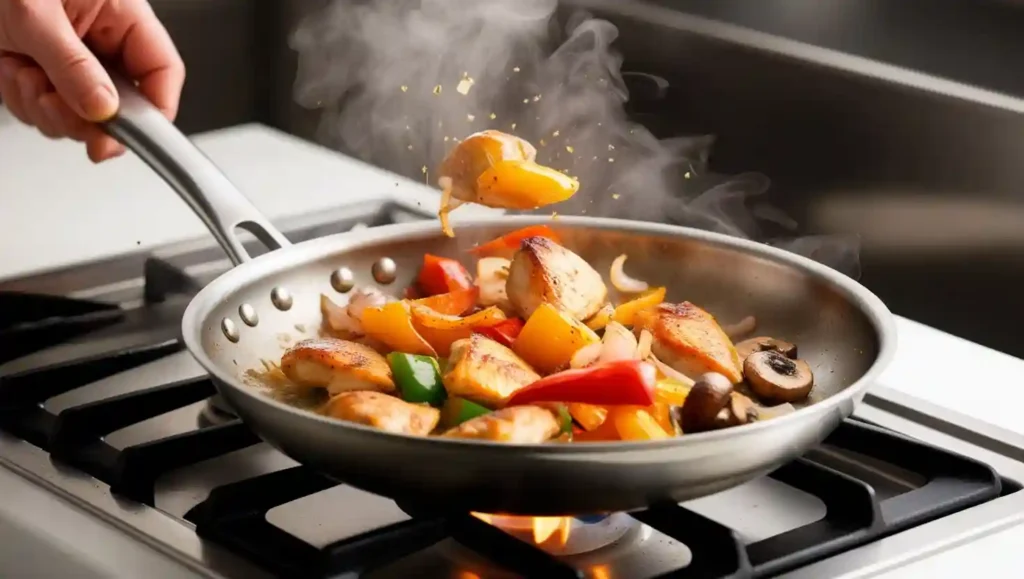
Sautéing is a dry-heat cooking method that uses a small amount of fat in a shallow pan over relatively high heat. The food is tossed or stirred frequently to ensure even cooking and prevent burning. This technique enhances flavours through caramelisation and is commonly used for proteins and vegetables.
Applications:
- Proteins: Chicken breast, shrimp, thin cuts of meat.
- Vegetables: Onions, bell peppers, mushrooms.
Advantages:
- Quick and efficient cooking method.
- Enhances flavours through caramelisation.
- Requires minimal oil for a healthier option.
Considerations:
- Requires constant attention to prevent burning.
- Best suited for small, tender food items.
- Cooking time must be carefully managed to avoid overcooking.
1.6 Frying
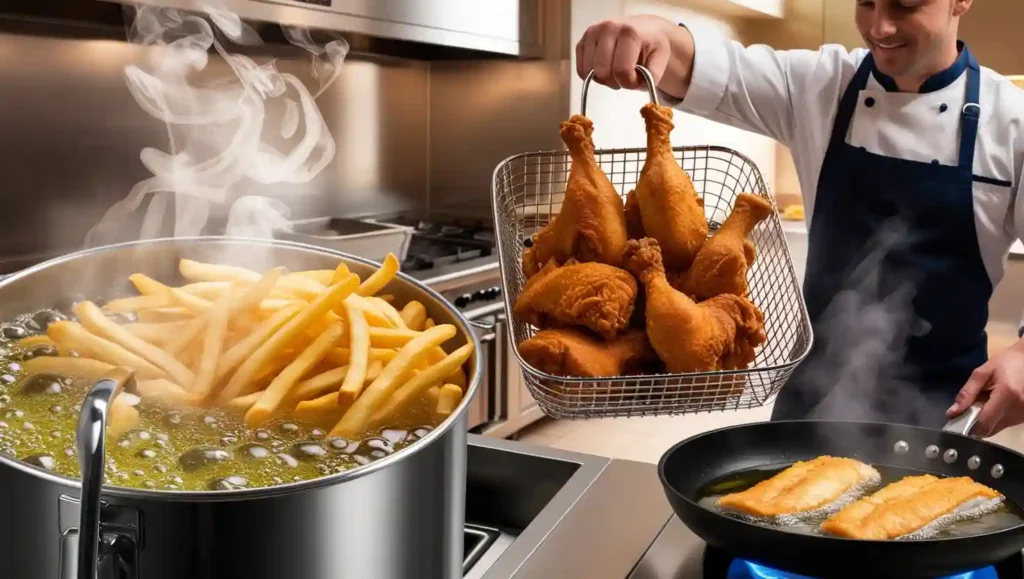
Frying involves cooking food in hot fat or oil, resulting in a crispy exterior and moist interior. This method provides rich flavours and textures, making it popular for a variety of dishes. The process requires proper temperature control to achieve the desired crispiness while preventing excessive oil absorption.
Frying Methods
1 Deep-Frying
- Submerging food completely in hot oil results in a crispy texture.
- Commonly used for French fries, doughnuts, and fried chicken.
- Requires precise temperature control (typically 350-375°F or 175-190°C).
2 Pan-Frying
- Uses less oil than deep-frying and is best for foods like fish fillets and pork chops.
- Food is cooked in a shallow layer of fat, allowing for controlled browning.
- Requires flipping for even cooking.
3 Stir-Frying
- A quick cooking technique involving high heat and constant stirring, often used in Asian cuisine.
- Small, uniform pieces of food are cooked rapidly with minimal oil.
- Preserves the colour, texture, and nutrients of vegetables and meats.
Advantages:
- Produces crispy, flavorful textures.
- Quick cooking time preserves moisture.
- Versatile method for various cuisines and ingredients.
Considerations:
- High fat content may make it less healthy.
- Oil temperature must be monitored carefully.
- Excess oil absorption can be avoided by proper draining techniques.
Also read: 10 Different Chicken Cuts with Pictures & Their Best Uses
1.7 Searing
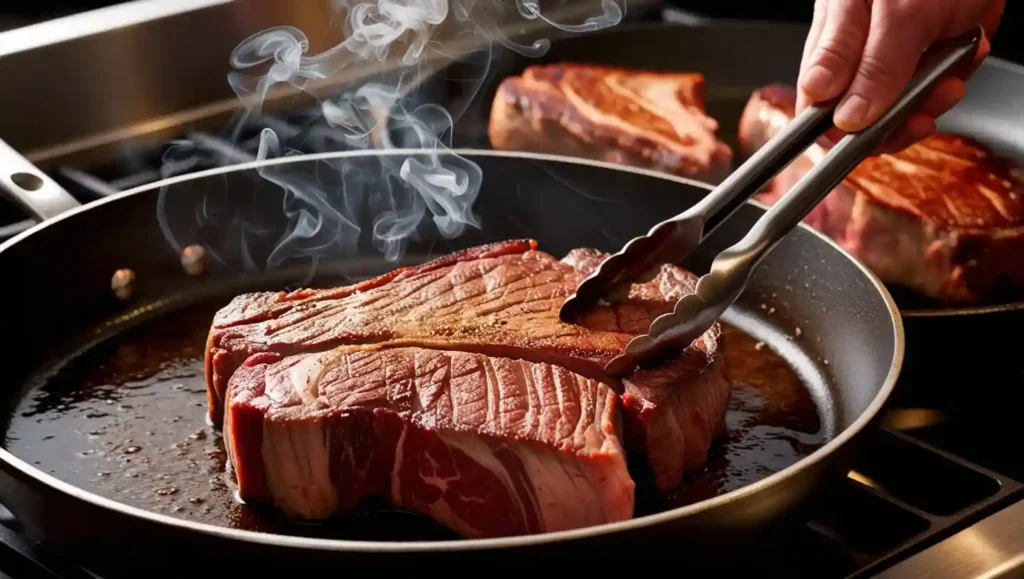
Searing involves cooking food at high temperatures to create a caramelised crust while keeping the inside tender. This technique is commonly used for meats before finishing in an oven or slow cooker. The high heat enhances the flavour by developing a rich, golden-brown exterior through the Maillard reaction.
Applications:
- Meats: Steaks, roasts, lamb chops.
- Seafood: Scallops, tuna steaks.
- Vegetables: Mushrooms, asparagus.
Advantages:
- Locks in juices and enhances flavour.
- Creates a flavorful, crisp outer crust.
- Quick cooking method for adding depth to dishes.
Considerations:
- Requires proper pan preheating.
- Best used in combination with other cooking methods.
- It can produce smoke if the oil temperature is too high.
1.8 Smoking

Smoking uses indirect heat and wood smoke to cook and flavour food. This slow-cooking method infuses deep, complex flavours into meats, seafood, and some vegetables. Different types of wood, such as hickory, mesquite, or applewood, influence the final taste of the dish.
Applications:
- Meats: Brisket, ribs, sausages.
- Seafood: Salmon, trout.
- Vegetables: Peppers, mushrooms.
Advantages:
- Imparts deep, smoky flavours.
- Preserve food for longer durations.
- Enhances tenderness through slow cooking.
Considerations:
- Requires specialised equipment.
- Time-consuming process.
- Temperature and smoke levels must be carefully controlled.
2. Moist Heat Cooking Methods
Moist heat cooking methods use water, steam, or other liquids to cook food gently, ensuring even heat distribution. These techniques are ideal for tenderising tougher cuts of meat while preserving moisture and nutrients. Common methods include boiling, steaming, poaching, and stewing, each offering unique benefits. They are widely used for preparing healthy and flavorful dishes with minimal added fats.
2.1 Boiling
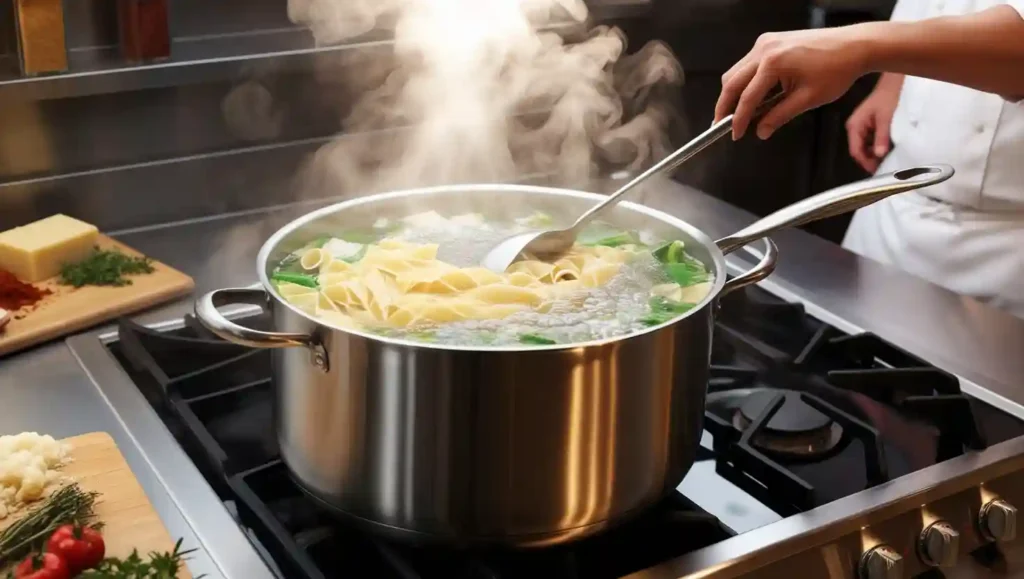
Boiling involves cooking food in water or broth at 212°F (100°C). This method is widely used for preparing pasta, grains, vegetables, and legumes. The high temperature ensures thorough cooking, making it ideal for breaking down tough fibres in food.
Applications:
- Grains & Pasta: Rice, quinoa, pasta, couscous.
- Vegetables: Potatoes, carrots, corn.
- Proteins: Eggs, seafood, poultry (for soups and stews).
Advantages:
- Simple and efficient cooking method.
- Retains natural flavours when done correctly.
- Softens tough ingredients for easier consumption.
Considerations:
- May result in bland flavours if not seasoned properly.
- This can lead to nutrient loss if water is discarded.
- Requires careful timing to prevent overcooking.
2.2 Simmering
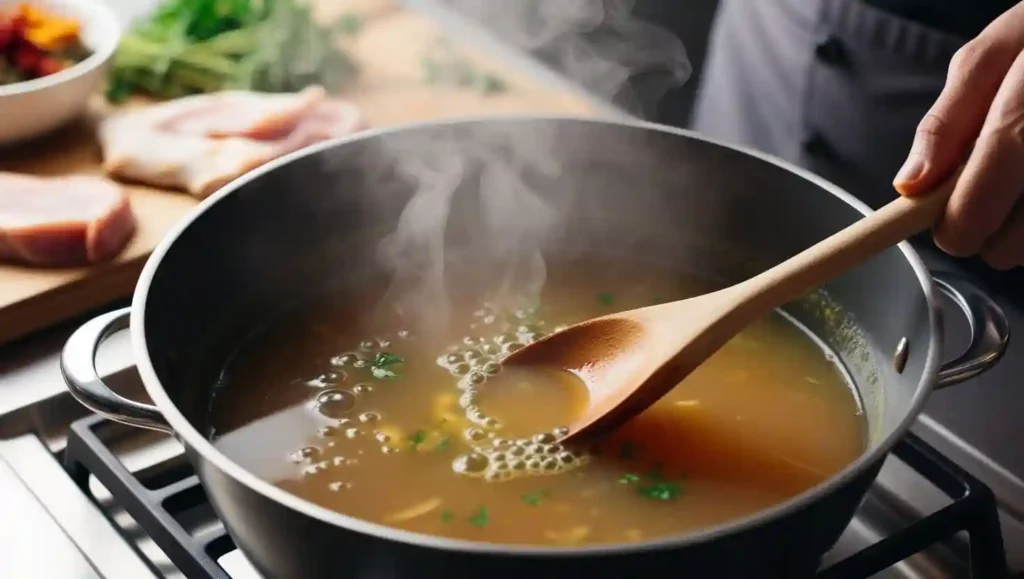
Simmering cooks food in liquid at a lower temperature (180-200°F or 82-93°C), just below boiling. This gentle cooking method allows flavours to meld, creating rich, complex dishes. It is ideal for breaking down tougher ingredients without causing them to fall apart. Simmering is commonly used in slow-cooked dishes, helping to tenderise proteins and develop depth of flavour. It is especially beneficial for soups, stews, and sauces.
Applications:
- Soups & Stews: Chicken soup, beef stew, chilli.
- Sauces: Tomato sauce, curry, béchamel.
- Proteins: Braised meats, legumes, and tougher cuts of meat.
Advantages:
- Enhances flavour development over time.
- Preserves tenderness and texture of ingredients.
- Reduces the risk of overcooking delicate foods.
Considerations:
- Requires longer cooking times.
- Needs occasional stirring to prevent sticking.
- It can cause evaporation, requiring liquid replenishment.
2.3 Poaching
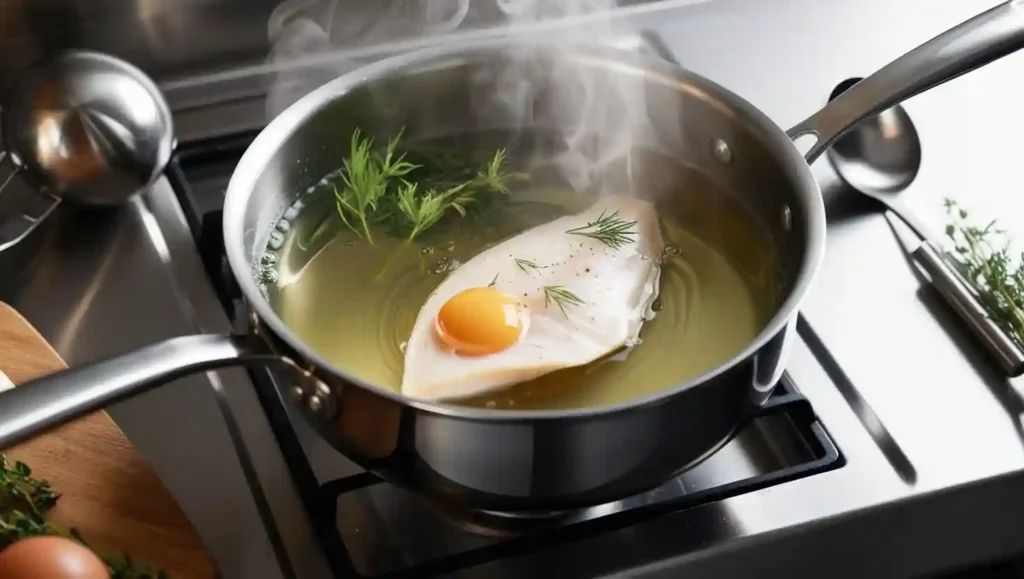
Poaching gently cooks food in liquid at 160-180°F (71-82°C), keeping it just below a simmer. This technique is perfect for delicate ingredients that require gentle handling to maintain their structure. The low temperature helps proteins retain moisture while preventing them from becoming tough. It is often done using water, broth, or flavoured liquids to enhance the taste. Poaching is a popular method for preparing tender meats, eggs, and even fruits.
Applications:
- Eggs: Poached eggs (e.g., Eggs Benedict).
- Seafood: Poached salmon, shrimp, or cod.
- Meats & Fruits: Chicken breast, pears, apples.
Advantages:
- Retains moisture and delicate texture.
- Produces tender, evenly cooked food.
- Requires little to no added fat.
Considerations:
- Requires precise temperature control.
- It can be less flavorful if not paired with aromatic liquids.
- Cooking time must be monitored to avoid mushiness.
2.4 Steaming

Steaming involves cooking food using steam from boiling water, which surrounds the food without direct contact with water. This method helps retain nutrients, moisture, and natural flavours while preserving the food’s texture and colour. Steaming is widely used in healthy cooking since it does not require added fats or oils. It ensures that ingredients remain tender without becoming mushy. This gentle technique is suitable for vegetables, seafood, grains, and dumplings.
Types of Steaming: Direct and Indirect
Steaming is categorised into two types: indirect steaming and direct steaming, each offering distinct techniques for cooking food efficiently while retaining moisture and nutrients.
A) Indirect Steaming
In indirect steaming, food is placed in a closed pan or container, surrounded by abundant steam from rapidly boiling water. This method ensures gentle, even cooking without direct contact with water. It is commonly used in steamers for preparing dumplings, seafood, and grains.
B) Direct Steaming
Direct steaming involves placing food on a covered plate or rack positioned over a saucepan of boiling water. The steam rises directly to cook the food while preserving its natural flavours and textures. This method is ideal for vegetables, fish, and soft proteins.
Applications:
- Vegetables: Broccoli, carrots, asparagus.
- Seafood: Fish fillets, shellfish.
- Grains & Dumplings: Rice, dim sum, and bao buns.
Advantages:
- Retains maximum nutrients and flavour.
- Requires no added fat, making it a healthy option.
- Prevents food from drying out.
Considerations:
- Overcrowding can result in uneven cooking.
- Requires specialised steaming equipment.
- Cooking times must be adjusted for different ingredients.
Also Read: 11 Types of Fish Cuts: Uses and Best Cooking Methods
2.5 Blanching
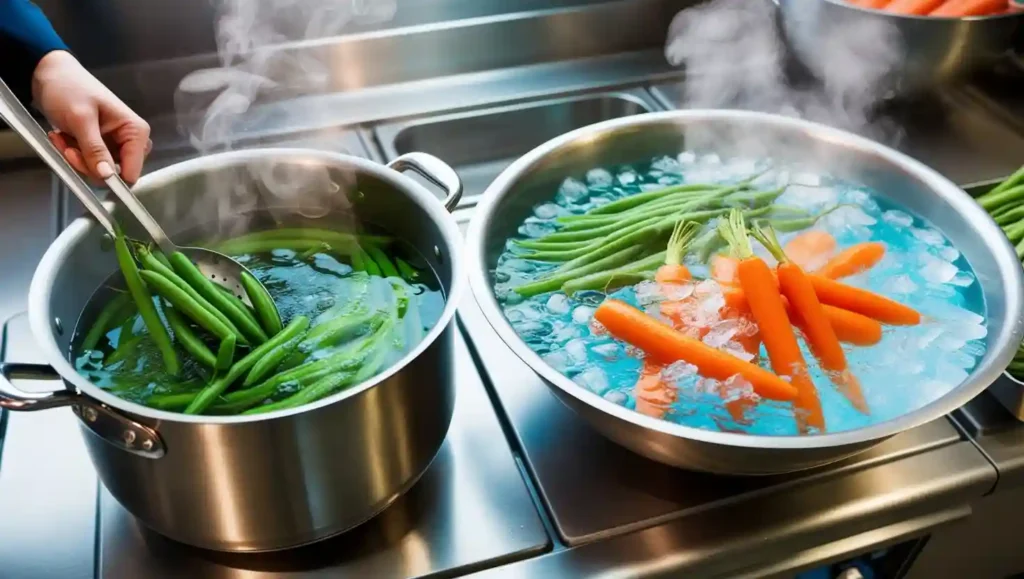
Blanching involves briefly boiling food and then rapidly cooling it in ice water to halt the cooking process. This technique helps preserve colour, texture, and nutrients in vegetables while reducing microbial activity. It is commonly used to prepare foods for freezing, peeling, or further cooking. Blanching also removes raw flavours and makes ingredients more digestible. This method is frequently applied to vegetables, fruits, and nuts.
Applications:
- Vegetables: Preparing green beans, carrots, and broccoli for freezing.
- Fruits: Loosening the skins of tomatoes and peaches for easy peeling.
- Nuts: Removing skins from almonds and peanuts.
Advantages:
- Retains vibrant colour and nutrients in vegetables.
- Makes peeling easier by loosening skin.
- Reduces microbial growth and enzyme activity.
Considerations:
- Requires immediate cooling to prevent overcooking.
- Can result in nutrient loss if not done correctly.
- Must be carefully timed for optimal texture.
2.6 Scalding
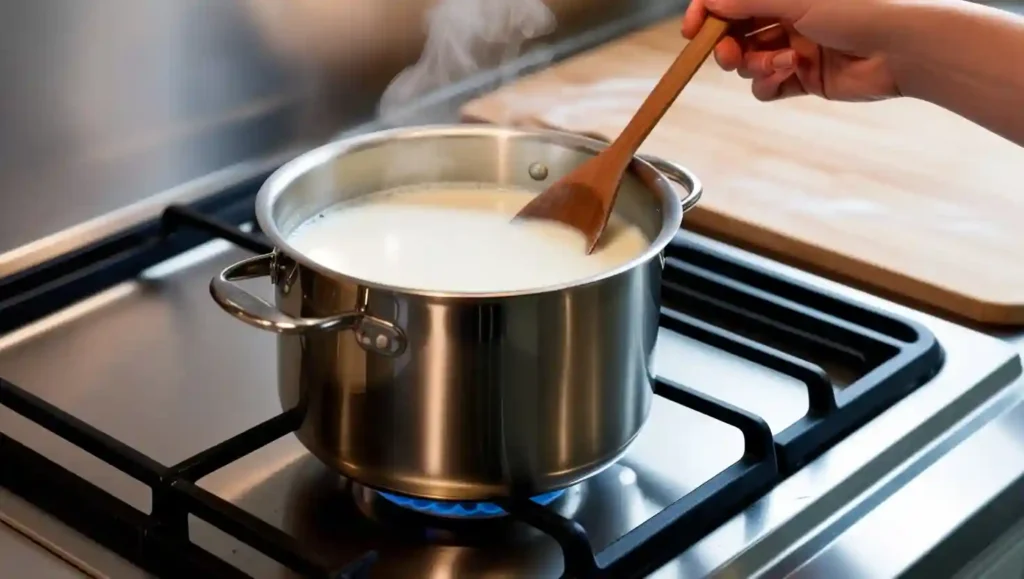
Scalding is a gentle heating process where food is exposed to water or milk at approximately 150°F (65°C). It is primarily used in dairy processing to kill bacteria and enzymes that can affect texture and shelf life. This method is also used to prepare ingredients for baking, such as softening milk for bread dough. Scalding helps improve food safety and enhances the consistency of certain dishes. It is commonly applied in dairy production and baking.
Applications:
- Dairy Processing: Heating milk to destroy harmful bacteria before pasteurization.
- Baking: Scalding milk for bread, custards, and puddings.
- Fruit Peeling: Loosening the skin of fruits like peaches before further processing.
Advantages:
- Improves the texture and shelf life of dairy products.
- Enhances flavour absorption in baked goods.
- Helps remove unwanted bacteria and enzymes.
Considerations:
- Must be monitored to prevent scorching or burning.
- Requires precise temperature control to avoid overheating.
- Can alter the nutritional properties of milk if not done correctly.
3. Combination Cooking Methods
Combination cooking methods use both dry and moist heat to develop deep flavours and tender textures. These techniques typically involve searing food at high temperatures before slowly cooking it in liquid. This process enhances taste, ensures even cooking, and is ideal for tougher cuts of meat. Common methods include braising, stewing, sous vide, and pot roasting, each contributing unique textures and flavours.
3.1 Braising

Braising involves searing food at high heat and then slowly cooking it in liquid at a low temperature. This method helps break down tough connective tissues, making it ideal for tougher cuts of meat. The combination of dry and moist heat results in rich, deeply flavoured dishes. Braising is commonly used for meats, vegetables, and legumes. It is often done in a covered pot or Dutch oven.
Applications:
- Meats: Beef short ribs, pork shoulder, lamb shanks.
- Vegetables: Cabbage, leeks, fennel.
- Legumes: Chickpeas, lentils, white beans.
Advantages:
- Produces tender, flavorful dishes.
- Ideal for tougher, budget-friendly cuts.
- Enhances the depth of flavour through slow cooking.
Considerations:
- Requires longer cooking times.
- Needs careful liquid control to avoid dryness or excess moisture.
- Best suited for large batches rather than quick meals.
For a guide on braising techniques, including how to achieve tender, flavorful results, visit America’s Test Kitchen’s Braising Techniques page.
3.2 Stewing

Stewing involves cooking small, uniform pieces of food in liquid over low heat for an extended period. This technique allows flavours to meld and ingredients to become tender. Stewing is a great way to use inexpensive cuts of meat and root vegetables. The liquid used in stewing, such as broth or wine, often becomes a flavorful sauce. It is a staple method for comfort food dishes.
Applications:
- Meats: Beef stew, chicken stew, lamb curry.
- Vegetables: Potatoes, carrots, mushrooms.
- Legumes: Lentil stew, bean stew.
Advantages:
- Creates rich, hearty meals with deep flavours.
- Makes use of affordable ingredients.
- Produces a built-in sauce for serving.
Considerations:
- Requires long cooking time for best results.
- Ingredients must be cut evenly for uniform cooking.
- Stirring occasionally is necessary to prevent sticking.
Also Read: 14 Essential Vegetable Cuts: Techniques, Uses, and Sizes
3.3 Sous Vide

Sous vide is a precise cooking method where food is vacuum-sealed and cooked in a temperature-controlled water bath. This technique ensures even cooking and locks in moisture, resulting in tender and flavorful dishes. It is commonly used for proteins but can also be applied to vegetables and desserts. Cooking times vary but are usually longer than traditional methods. Sous vide cooking requires specialised equipment like an immersion circulator.
Applications:
- Proteins: Steak, chicken breast, salmon.
- Vegetables: Carrots, asparagus, potatoes.
- Desserts: Custards, crème brûlée, poached pears.
Advantages:
- Ensures precise, even cooking.
- Preserve natural juices and flavours.
- Reduces the risk of overcooking.
Considerations:
- Requires sous vide equipment.
- Cooking times can be lengthy.
- Needs finishing steps like searing for texture.
3.4 En Papillote
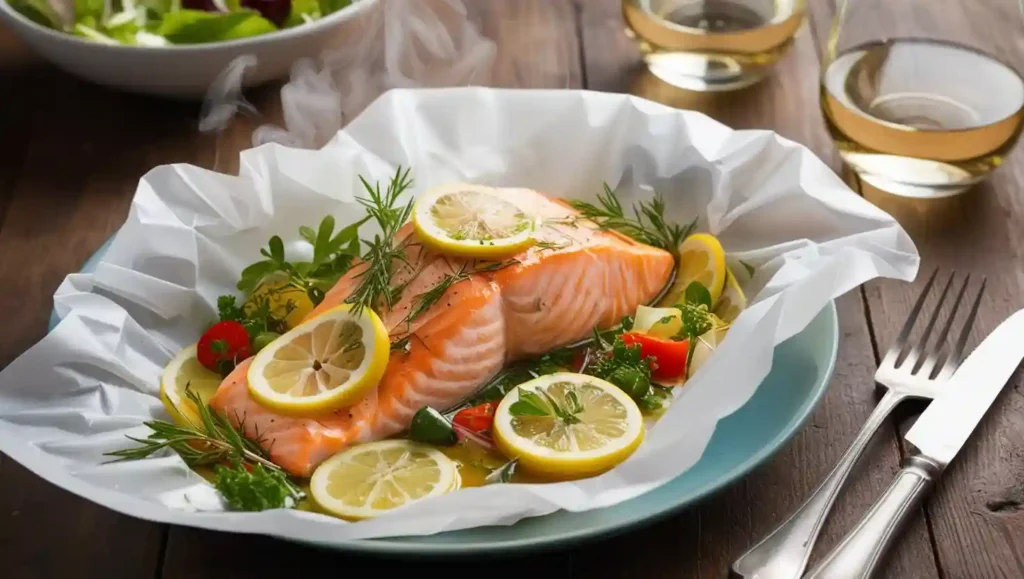
En papillote is a cooking method where food is wrapped in parchment paper and baked, allowing it to steam in its own juices. This technique preserves moisture and enhances natural flavours without requiring added fats. The steam gently cooks the food while infusing it with herbs, spices, and aromatics. It is commonly used for delicate proteins and vegetables. The presentation is also visually appealing, making it ideal for elegant dishes.
Applications:
- Proteins: Fish fillets, shrimp, chicken breast.
- Vegetables: Asparagus, zucchini, bell peppers.
- Aromatics: Lemon slices, garlic, fresh herbs.
Advantages:
- Locks in moisture and flavour.
- Requires little to no added fat.
- Produces a visually appealing presentation.
Considerations:
- Cooking times must be precise.
- Requires careful sealing of parchment paper.
- Best suited for delicate proteins.
Conclusion: Cooking methods play a crucial role in shaping the taste, texture, and nutritional value of food. Whether using dry heat, moist heat, or combination techniques, each method offers unique benefits suited for different ingredients and dishes. Understanding these methods helps in selecting the best approach for enhancing flavours and achieving desired results. By mastering various cooking techniques, you can elevate your culinary skills and create delicious, well-prepared meals.
Also Read:
This article was written by Saswata Banerjee, the creator of Food and Beverage Service Knowledge, based on 8+ years of experience in the hospitality industry.

